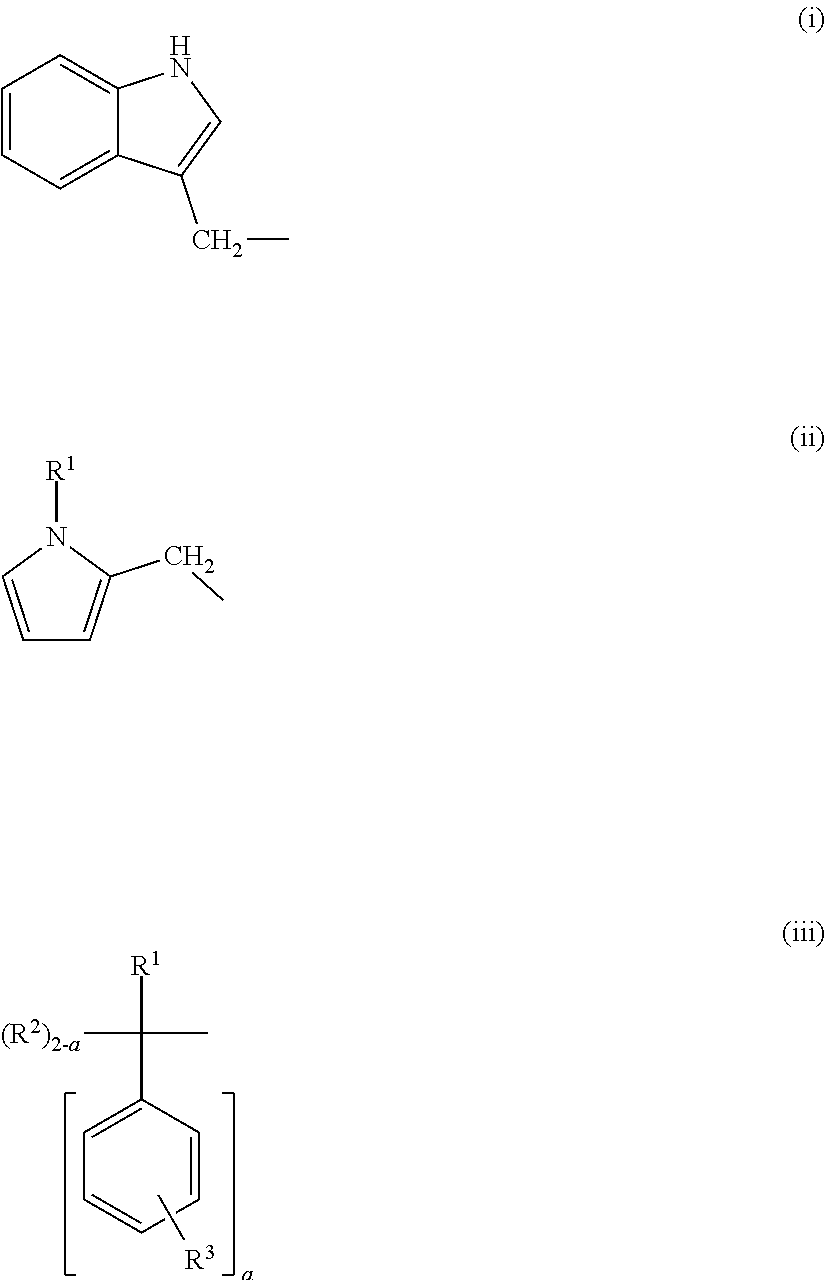Novel carbamate ester compound and acrylic rubber composition containing the same
a carbamate ester compound and compound technology, applied in the field of new carbamate ester compound and acrylic rubber composition containing the same, can solve the problems of shortening the scorch time, and affecting the vulcanization rate of the compound, and achieve short time injection molding. , the effect of excellent scorch stability
- Summary
- Abstract
- Description
- Claims
- Application Information
AI Technical Summary
Benefits of technology
Problems solved by technology
Method used
Image
Examples
example 1
[0056]In a 200 ml eggplant shaped flask, 11.00 g (74.7 mmol) of indolylmethanol (produced by Tokyo Chemical Industry Co., Ltd.) and 24 g of methyl ethyl ketone were charged, and stirred for dissolution in a water bath at 25° C. Then, 2 g of methyl ethyl ketone solution with 144 mg (0.228 mmol) of dibutyltin dilaurate (produced by FUJIFILM Wako Pure Chemical Corporation) dissolved therein was added. Subsequently, 24 g of methyl ethyl ketone solution with 6.00 g (35.6 mmol) of hexamethylene diisocyanate (produced by Tokyo Chemical Industry Co., Ltd.) was added dropwise in 2 or 3 batches, and the mixture was allowed to stand for 5 minutes.
[0057]After the completion of the reaction, the resultant was dried under reduced pressure at room temperature for 5 hours, thereby obtaining 17.24 g of a light brown crude powdered solid [carbamate ester compound A].
[0058]The structure of the obtained solid was identified using 1H NMR (Aceton-d6) and FT-IR.
[0059]1H NMR: (a) 7.7 ppm (d 2H)[0060](b) 7....
example 2
[0072]In a 50 ml eggplant shaped flask, 6.23 g (56.1 mmol) of N-methyl-2-hydroxymethylpyrrole (produced by Tokyo Chemical Industry Co., Ltd.) was charged, and 2 g of methyl ethyl ketone solution with 108 mg (0.171 mmol) of dibutyltin dilaurate dissolved therein was added. Subsequently, 6 g of methyl ethyl ketone solution with 4.50 g (26.7 mmol) of hexamethylene diisocyanate dissolved therein was added dropwise, and the mixture was stirred in a water bath at 25° C. for 1.5 hours.
[0073]After the completion of the reaction, the resultant was dried under reduced pressure at room temperature for 8 hours, thereby obtaining 10.79 g (yield: 99%) of a light brown powdered solid [carbamate ester compound B].
[0074]The structure of the obtained solid was identified using 1H NMR and FT-IR.
[0075]1H NMR: (a) 3.6 ppm (s 6H)[0076](b) 6.6 ppm (t 2H)[0077](c) 6.2 ppm (q 2H)[0078](d) 6.1 ppm (t 2H)[0079](e) 5.0 ppm (s 4H)[0080](f) 6.6 ppm (s 2H)[0081](g) 3.1 ppm (m 4H)[0082](h) 1.5 ppm (m 4H)[0083](i) ...
example 3
[0086]In a 100 ml two-necked eggplant shaped flask, 11.16 g (56.25 mmol) of 1,1-diphenylethanol (produced by Tokyo Chemical Industry Co., Ltd.) was charged, and 2 g of methyl ethyl ketone solution with 360 mg (0.570 mmol) of dibutyltin dilaurate dissolved therein was added. Subsequently, 4 g of methyl ethyl ketone solution with 4.50 g (26.7 mmol) of hexamethylene diisocyanate dissolved therein was added dropwise, and the mixture was stirred for 5.5 hours in the reactor warmed at 80° C.
[0087]After the completion of the reaction, the insoluble portion was filtered and washed with n-hexane, and the filtrate was dried under reduced pressure at room temperature for 8 hours, thereby obtaining 14.25 g (yield: 94%) of a white powdered solid [carbamate ester compound C].
[0088]The structure of the obtained solid was identified using 1H NMR and FT-IR.
[0089]1H NMR: (a), (b), (c) 7.2-7.3 ppm (m 20H)[0090](d) 2.2 ppm (s 6H)[0091](c), (d) 7.4 ppm (m 4H)[0092](e) 4.8 ppm (s 2H)[0093](f) 3.0 ppm (m ...
PUM
| Property | Measurement | Unit |
|---|---|---|
| weight | aaaaa | aaaaa |
| heat resistance | aaaaa | aaaaa |
| compression set | aaaaa | aaaaa |
Abstract
Description
Claims
Application Information
 Login to View More
Login to View More - R&D
- Intellectual Property
- Life Sciences
- Materials
- Tech Scout
- Unparalleled Data Quality
- Higher Quality Content
- 60% Fewer Hallucinations
Browse by: Latest US Patents, China's latest patents, Technical Efficacy Thesaurus, Application Domain, Technology Topic, Popular Technical Reports.
© 2025 PatSnap. All rights reserved.Legal|Privacy policy|Modern Slavery Act Transparency Statement|Sitemap|About US| Contact US: help@patsnap.com



